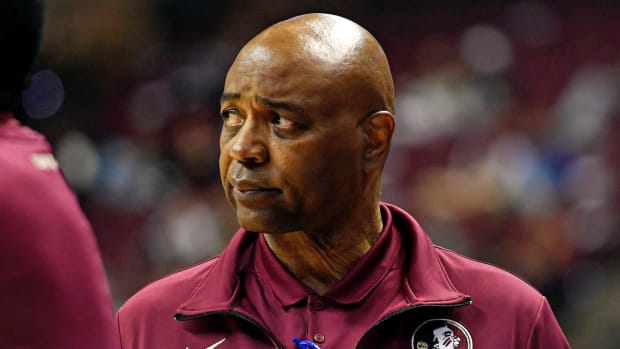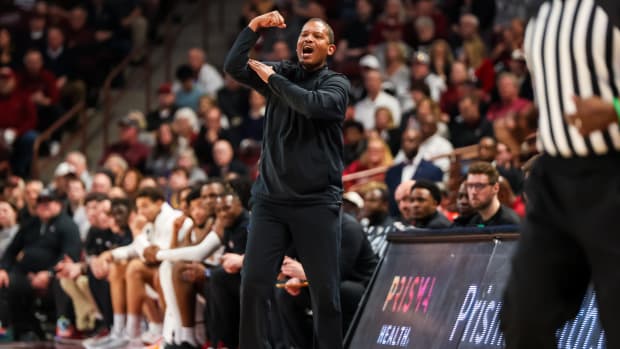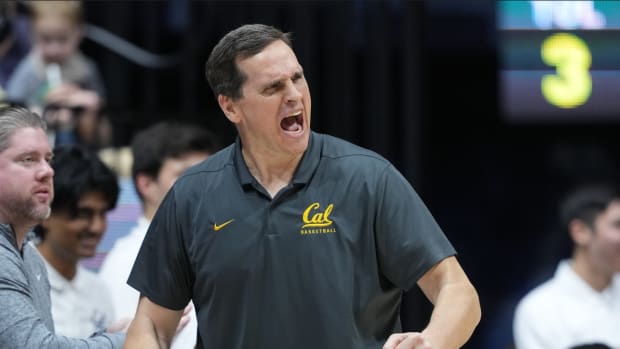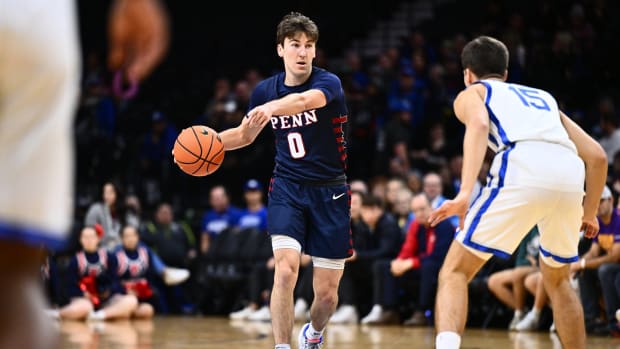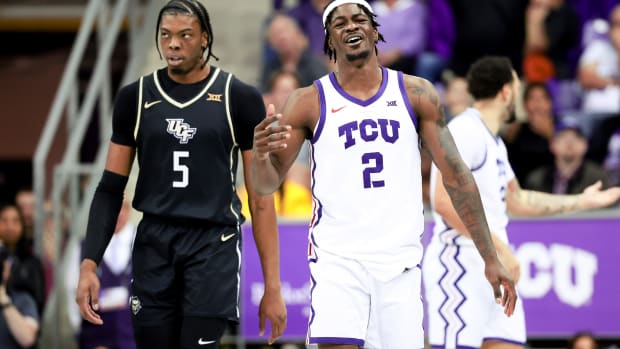Bracket Watch: Projecting the Men’s Top 16 Seeds
Friday’s updated men’s NCAA tournament bracket is the last one we’ll post with no insight into what the committee is thinking. On Saturday, the selection committee will announce its mock top 16, which should point us toward the teams whose résumés are favored more (and less) by the people actually in the room making the decisions compared to how I’ve evaluated them.
Until then, here’s an updated look at Sports Illustrated’s projected field (click here for full bracket view), as well as answers to all your bracket-related questions from the week.
| WEST | SOUTH | MIDWEST | EAST |
|---|---|---|---|
No. 1 Gonzaga vs. No. 16 Southern/New Orleans | No. 1 Auburn vs. No. 16 Cleveland St./UNC-W | No. 1 Arizona vs. No. 16 Norfolk State | No. 1 Kansas vs. No. 16 Colgate |
No. 8 Murray St. vs. No. 9 Iowa | No. 8 Wyoming vs. No. 9 TCU | No. 8 Iowa State vs. No. 9 Loyola Chicago | No. 8 Xavier vs. No. 9 Boise State |
No. 5 Ohio St. vs. No. 12 North Texas | No. 5 Michigan St. vs. No. 12 Creighton/Memphis | No. 5 Alabama vs. No. 12 Rutgers/BYU | No. 5 Texas vs. No. 12 Chattanooga |
No. 4 Houston vs. No. 13 Iona | No. 4 UCLA vs. No. 13 Vermont | No. 4 Wisconsin vs. No. 13 South Dakota St. | No. 4 Illinois vs. No. 13 Ohio |
No. 6 UConn vs. No. 11 Davidson | No. 6 Saint Mary’s vs. No. 11 Indiana | No. 6 LSU vs. No. 11 Oklahoma | No. 6 USC vs. No. 11 Notre Dame |
No. 3 Texas Tech vs. No. 14 Yale | No. 3 Villanova vs. No. 14 Jacksonville St. | No. 3 Providence vs. No. 14 Wagner | No. 3 Tennessee vs. No. 14 New Mexico St. |
No. 7 Marquette vs. No. 10 San Francisco | No. 7 Seton Hall vs. No. 10 Wake Forest | No. 7 Colorado St. vs. No. 10 Miami | No. 7 Arkansas vs. No. 10 Michigan |
No. 2 Purdue vs. No. 15 Longwood | No. 2 Baylor vs. No. 15 Texas State | No. 2 Kentucky vs. No. 15 Montana St. | No. 2 Duke vs. No. 15 Long Beach St. |
On the Bubble
Last Four Byes:
San Francisco
Indiana
Notre Dame
Oklahoma
Last Four In:
Creighton
Memphis
Rutgers
BYU
First Four Out:
San Diego State
SMU
North Carolina
Belmont
Next Four Out:
Oregon
Kansas State
Virginia Tech
Dayton
Bracket Talk
Eric asks (via DMs): What’s your projected top 16 as of now?
1. Gonzaga
2. Auburn
3. Arizona
4. Kansas
5. Kentucky
6. Baylor
7. Duke
8. Purdue
9. Texas Tech
10. Villanova
11. Providence
12. Tennessee
13. Illinois
14. Wisconsin
15. Houston
16. UCLA
Here’s how I currently have the list for the 1–4 seeds. As I’ve alluded to multiple times in recent Mailbags and other bracket-related content, the big story line I’ll be watching is how Houston and Providence are seeded, given that the two teams essentially have opposite résumés. One team (Houston) is reliant on predictive metrics, while the other (Providence) is favored in results-based metrics and Quadrant 1 wins. That, plus the question of who the last No. 1 seed is (Kansas vs. Kentucky was what my debate came down to) will shed some light on how the committee is thinking.
(UPDATE: The committee released its official top 16 on Saturday, which can be viewed here).
Brian asks: Where would you have Rutgers in the field? While Phil asks: How high can Rutgers climb as far as seeding goes?
After Wednesday’s win over Illinois to notch the team’s fourth straight Quad 1 win, the Scarlet Knights join the field for the first time this season. Rutgers’s poor metrics made it tight, but in the end a 6–3 record in Q1 games was too good for me to leave it out at this point. There is some precedent for a team with a NET in the 70s getting an at-large, as St. John’s in 2019 entered Selection Sunday at No. 72 in the NET and got sent to the First Four. That Red Storm team also had two Q3/4 losses, while Rutgers has three. I think a 3–2 finish to the regular season would get the Scarlet Knights into the field.
In terms of a ceiling seed-wise, it’s hard to know without knowing how much more they can get their metrics to rise. Personally, I’d be pretty surprised if they can top a No. 9/10 seed without doing something like winning the Big Ten tournament. As long as the Scarlet Knights have the worst metrics among the at-large pool, combined with their three bad losses, it’s hard to see them ever clearing the bubble cut line by too much.
Matthew asks: Surprisingly, I think Virginia Tech is back on the bubble after a bad ACC start. What do the Hokies need to do to get in the dance?
Virginia Tech’s six-game winning streak has at least opened the door for the Hokies to sneak into the field. Still, the path is very narrow, and I think it likely involves winning out in the regular season.
The biggest thing going for VT is its predictive metrics. The Hokies are No. 35 in the NET and No. 28 in KenPom, in both cases the highest-rated team not to make our current field. But with no Q1 wins and two Q3 losses, the résumé just isn’t there to warrant serious consideration yet. That could change down the stretch, with a Q1 opportunity at Miami next weekend and the chance to host North Carolina this weekend in a battle of potential bubble teams.
Without adding a Q1 win before the ACC tournament, the Hokies would likely need at least a run to the final to get in the field. But if they can win out and enter the conference tournament with what would likely be a top-30 NET and eight Q1 + Q2 wins, they’d certainly be in the conversation before their final chance to make an impression on the committee in Brooklyn.
Max asks: Is a three-bid OVC possible?
Unfortunately, I can’t see it. The only way I see Belmont getting an at-large bid is if it beats Murray State next week and then loses to the Racers in the OVC tournament final. A third bid would be predicated upon the Belmont losing to a non-Murray team, given that the two teams will be on opposite sides of the bracket in their conference tournament.
Murray State is very close to a lock. I’d imagine the Racers would get in even if they lost to Belmont next week and lost in the OVC tournament, though they can be safe and win out to lock in their bid before the conference tournament. But while Belmont is a quality team with strong metrics and March experience, it’s hard for me to see it getting an at-large if it adds a Q3 or Q4 loss to an otherwise-clean résumé—especially because the Bruins already have a losing record in Q1 + Q2 games. Now, it’s possible Morehead State would jump into Quad 2 if it beats both Belmont and Murray, and you’d wind up with Murray and Morehead in with Belmont sweating the bubble. I still think, in that circumstance, Belmont would be left out—but it at least would be close.
BCV asks: Where do you have Tennessee slotted in the field today and what is the highest seed possible for the Vols?
The Vols are our last No. 3 seed in the field in Friday’s update, good for No. 12 on the seed list. After Tuesday’s win over Kentucky, Tennessee has two elite wins and still no losses outside of Q1. The only thing worth criticizing with the Vols’ résumé is the team’s 5–6 record in Q1 games, which has kept the Vols from climbing even higher on the seed list.
From a ceiling standpoint, the Vols don’t have a real path to a No. 1 seed. That said, sneaking onto the No. 2 line isn’t out of the question. They’d likely need a team such as Purdue to slip up once or twice between now and Selection Sunday, but with wins over Kentucky and Arizona and a crack at Auburn this weekend, the No. 2 line feels attainable.
Kody asks: How do you think the committee handles Mountain West seeding? Are they mostly going to get stuck in the 8–10 range?
For now, the three Mountain West teams in the best position to go dancing (Wyoming, Boise State and Colorado State) are likely to find themselves in that 8–10 range. I might even open that up to 7–10, but the No. 7 line feels like a realistic ceiling for those three clubs.
For a mid-major league to produce a better seed than that requires a team completely dominating it. That hasn’t happened with the Mountain West, as Boise, Wyoming and CSU have all taken losses in conference play (Wyoming and CSU each have Quad 3 losses from conference play). But having three teams clearly above the bubble at this point in time is a great sign for the league, and there are enough quality win opportunities in the Mountain West that I expect that to mostly stay the same until Selection Sunday. Right now, we’re looking at more mid-majors in the No. 8 and No. 9 seeds and more high-majors in the No. 10 and No. 11 seed lines than usual, though that could change as high-major teams bolster their résumés come conference tournament time.
SI's projected field of 68 (as of Feb. 18):
More College Basketball Coverage:
• Dickie V Can’t Be Silenced
• One of These Eight Teams Will Win NCAA Tournament
• Coach K, the Ultimate Team Builder



